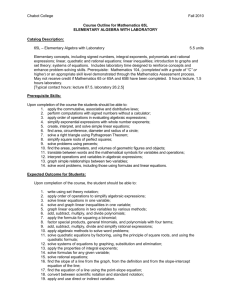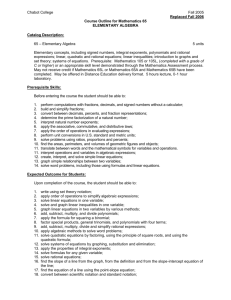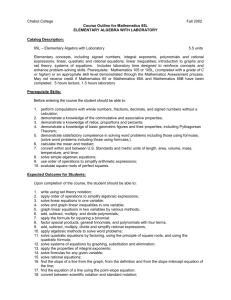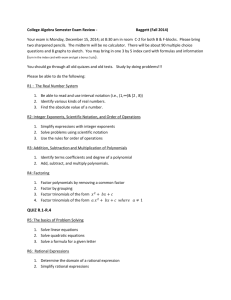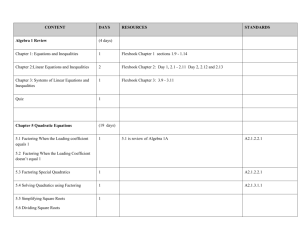Elementary Algebra with Laboratory
advertisement
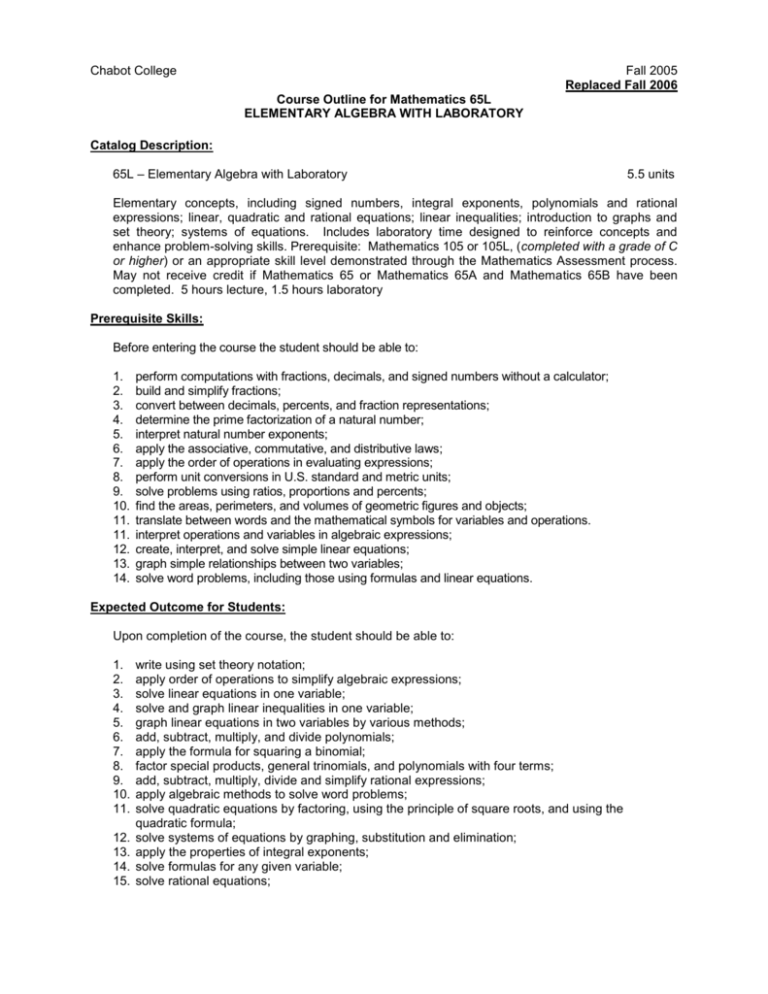
Chabot College Fall 2005 Replaced Fall 2006 Course Outline for Mathematics 65L ELEMENTARY ALGEBRA WITH LABORATORY Catalog Description: 65L – Elementary Algebra with Laboratory 5.5 units Elementary concepts, including signed numbers, integral exponents, polynomials and rational expressions; linear, quadratic and rational equations; linear inequalities; introduction to graphs and set theory; systems of equations. Includes laboratory time designed to reinforce concepts and enhance problem-solving skills. Prerequisite: Mathematics 105 or 105L, (completed with a grade of C or higher) or an appropriate skill level demonstrated through the Mathematics Assessment process. May not receive credit if Mathematics 65 or Mathematics 65A and Mathematics 65B have been completed. 5 hours lecture, 1.5 hours laboratory Prerequisite Skills: Before entering the course the student should be able to: 1. 2. 3. 4. 5. 6. 7. 8. 9. 10. 11. 11. 12. 13. 14. perform computations with fractions, decimals, and signed numbers without a calculator; build and simplify fractions; convert between decimals, percents, and fraction representations; determine the prime factorization of a natural number; interpret natural number exponents; apply the associative, commutative, and distributive laws; apply the order of operations in evaluating expressions; perform unit conversions in U.S. standard and metric units; solve problems using ratios, proportions and percents; find the areas, perimeters, and volumes of geometric figures and objects; translate between words and the mathematical symbols for variables and operations. interpret operations and variables in algebraic expressions; create, interpret, and solve simple linear equations; graph simple relationships between two variables; solve word problems, including those using formulas and linear equations. Expected Outcome for Students: Upon completion of the course, the student should be able to: 1. 2. 3. 4. 5. 6. 7. 8. 9. 10. 11. 12. 13. 14. 15. write using set theory notation; apply order of operations to simplify algebraic expressions; solve linear equations in one variable; solve and graph linear inequalities in one variable; graph linear equations in two variables by various methods; add, subtract, multiply, and divide polynomials; apply the formula for squaring a binomial; factor special products, general trinomials, and polynomials with four terms; add, subtract, multiply, divide and simplify rational expressions; apply algebraic methods to solve word problems; solve quadratic equations by factoring, using the principle of square roots, and using the quadratic formula; solve systems of equations by graphing, substitution and elimination; apply the properties of integral exponents; solve formulas for any given variable; solve rational equations; Chabot College Course outline for Math 65L, page 2 Fall 2005 Expected Outcome for Students – continued: 16. find the slope of a line from the graph, from the definition and from the slope-intercept equation of the line; 17. find the equation of a line using the point-slope equation; 18. convert between scientific notation and standard notation; 19. apply and use direct or indirect variation. Course Content: 1. Set theory notation 2. Real number system a. Properties of addition and multiplication b. Absolute value c. Order of operations d. Graphing on the number line 3. Algebraic expressions 4. Linear equations a. Solving b. Applications c. Formulas 5. Linear inequalities in one variable a. Solving b. Graphing on the number line c. Applications 6. Operations and simplifying polynomials 7. Factoring polynomials a. Removing common factors b. Trinomials c. Difference of two squares d. Grouping 8. Rational expressions a. Simplifying b. Operations c. Complex fractions 9. Solving rational equations 10. Introduction to systems of linear equations a. Graphing method b. Substitution method c. Elimination method d. Applications 11. Graphing linear equations in two variables a. Plotting points b. Plotting intercepts c. The slope-intercept method 12. Finding slope a. From the graph b. From two points c. From the slope-intercept equation 13. Finding linear equations given the graph of the line or information about the line 14. Exponents a. Integral b. Scientific notation 15. Simplifying square roots of constants 16. Quadratic equations Chabot College Course outline for Math 65L, page 3 Fall 2005 Course Content – continued: a. Solving by factoring b. Solving by principle of square roots c. Solving by using the quadratic formula Methods of Presentation: 1. 2. 3. 4. Informal lectures Student presentation of problems and solutions Class discussion of problems, solutions and students’ questions Audio-visual materials Assignments and Methods of Evaluating Student Progress: 1. Typical Assignments a. Exercises from the text book Do Problem Set 1-5. Be prepared to present one of your solutions to the class. Find more than one way to solve at least one of the problems. b. Collaborative Is n + 7 the opposite of n 7? Discuss this with your group. If it is true, write a convincing argument to explain why it is always true. If it is false, give a counter-example. 2. Methods of Evaluating Student Progress: a. Homework b. Quizzes c. Class participation d. Presentation of problems and solutions e. Midterms f. Final Exam Textbooks (Typical): Algebra I: A Process Approach,2nd edition. Rachlin, Matsumoto, Wada, and Dougherty. Curriculum Research and Development Group, University of Hawai’i, 2001. Elementary Algebra, Bittinger/Ellenbogen, Addison Wesley, 2002 A. Wah 09/17/01 MATH 65A Outline Fall 2002 Revised: 10/2004

